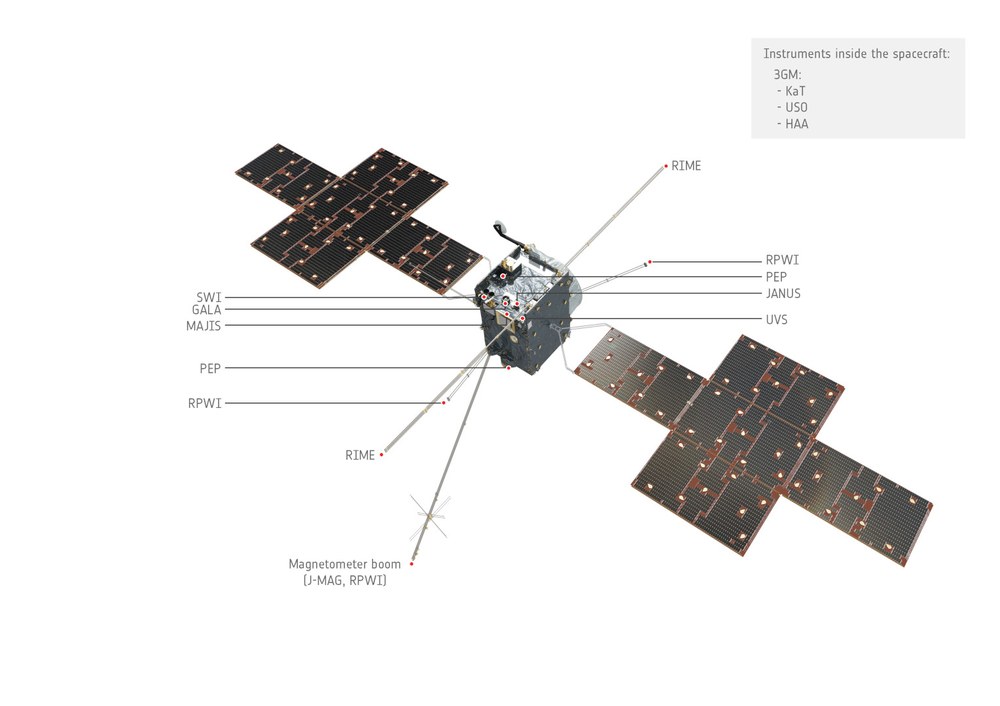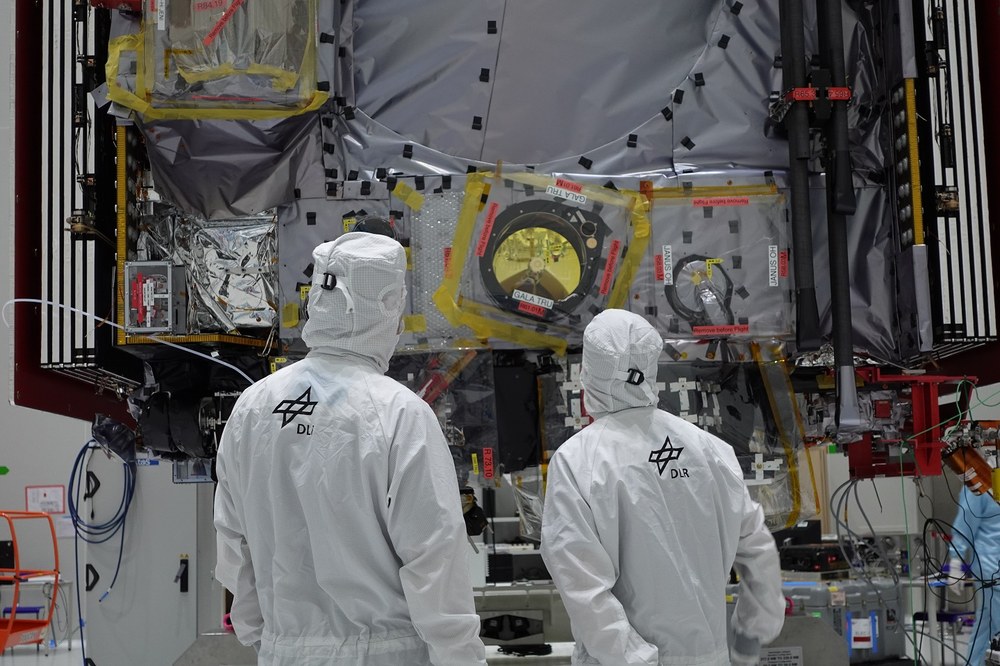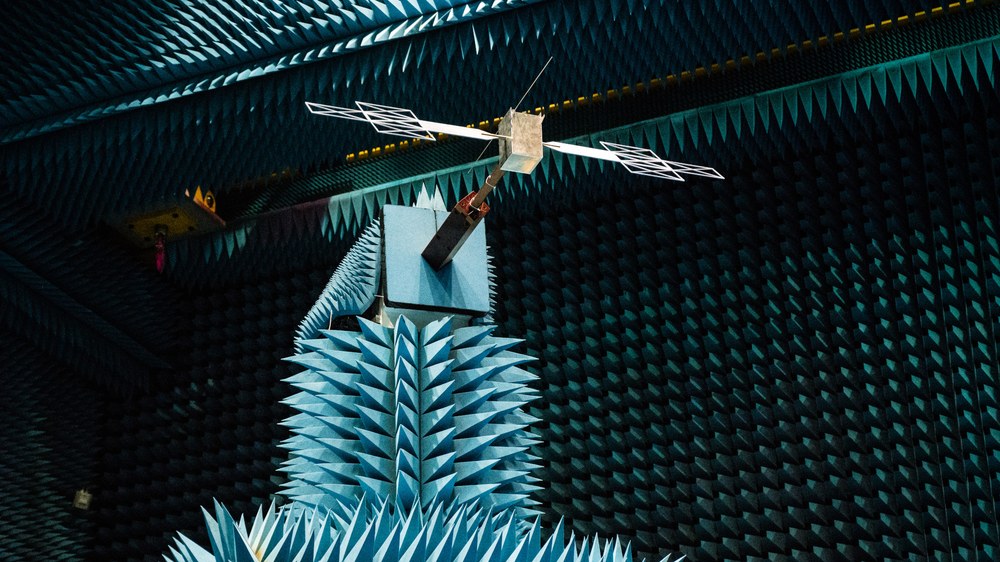The scientific instruments

ESA ATG Medialab

ESA

ESA/ M.Cowan
There are ten instruments on board the JUICE spacecraft: four for optical remote sensing, three for geophysical exploration and three for studying magnetospheres. JUICE’s scientific instruments will be complemented by a network of antennas set up by the Netherlands, with which the orbit of JUICE can be precisely measured. This instrument – the Planetary Radio Interferometer and Doppler Experiment (PRIDE) – is not located on board the spacecraft, but forms an additional experiment that is very important for the precision of many measurements carried out using the onboard instruments. PRIDE will make it possible to draw conclusions about the gravitational fields of Jupiter and its large moons.
Optical instruments
- Jovis, Amorum ac Natorum Undique Scrutator (JANUS) camera (Latin: 'comprehensive observation of Jupiter, its loves and descendants')
JANUS has 13 narrow-band colour filters and will be used to study the Jupiter system in a wide range of wavelengths from 350 to 1050 nanometres. The objectives are to map the global, regional and local structure and shape of the icy moons and to study the structure of Jupiter's clouds. Another goal is to observe Jupiter's small moons and rings. JANUS will be used to image Ganymede in its entirety with a resolution of 70 metres per pixel. The highest resolution achievable during close flybys of the icy moons is five metres per pixel.
The Principal Investigator of the experiment is Pasquale Palumbo from the University of Naples Parthenope. His deputy is Thomas Roatsch from the DLR Institute of Planetary Research. - Moons and Jupiter Imaging Spectrometer (MAJIS)
MAJIS will be used to observe its targets in many wavelength ranges simultaneously. The spectrum ranges from visible light (500 nanometres) to the near infrared (5.5 micrometres). The goals of MAJIS are similar to those of JANUS. The primary aim is to determine the material composition of the surfaces of the icy moons and Jupiter's atmosphere. The highest spatial resolution for images of Ganymede will be 25 metres per pixel.
The Principal Investigator of the experiment is Francois Poulet from the Observatoire de Paris Meudon. DLR is represented on the science team by Katrin Stephan from the Institute of Planetary Research. - UV Spectrometer (UVS)
UVS will be used to investigate the atmosphere of Jupiter and the exospheres – the gossamer atmospheres – of Jupiter's moons in wavelengths of ultraviolet light (55 to 210 nanometres). To study the exospheres, UVS will primarily use the stellar occultations that occur when a moon of Jupiter passes in front of a star of the cosmic background and its light undergoes spectral changes and attenuations as it passes through the moon's exosphere. The highest spatial resolution at Ganymede will be 0.5 kilometres per pixel.
The Principal Investigator of the experiment is Randy Gladstone from the Southwest Research Institute in Boulder, USA. - Sub-millimetre Wave Instrument (SWI)
SWI will be used to study the exospheres and the surfaces of the icy moons. It will also be used to study the composition and dynamics of Jupiter's stratosphere and troposphere. It consists of two channels for measuring wavelengths around 520 micrometres (frequencies of 530-625 Gigahertz) and 250 micrometres (1080-1275 Gigahertz) with a spectral resolution of 107.
The Principal Investigator of the experiment is Paul Hartogh from the Max Planck Institute for Solar System Research in Göttingen.
Geophysical instruments
- Ganymede Laser Altimeter (GALA)
GALA will be used to precisely measure the height differences and thus the topography on the surface of the large icy moons. For Europa and Callisto, this is done during individual flybys. In the case of Ganymede, this can be done over a wide area while JUICE is in its 'GCO500 orbit' – an orbit around Ganymede at an altitude of 500 kilometres above the surface. This will make it possible to detect changes to the surface caused by tidal deformation and allow researchers to draw conclusions about the existence of an ocean beneath the surface.
The Principal Investigator of the experiment is Hauke Hußmann from the DLR Institute of Planetary Research in Berlin-Adlershof. - Radar for Icy Moons Exploration (RIME)
With this radar experiment, researchers can explore up to nine kilometres beneath the surface of the icy moons at a frequency of nine megahertz. Observations will be made both during flybys of the icy moons and in low Ganymede orbit from an altitude of 500 kilometres. This will thus help researchers determine the existence of a sub-surface ocean.
The Principal Investigator of the experiment is Lorenzo Bruzzone from the University of Trento in Italy. - Gravity & Geophysics of Jupiter and the Galilean Moons (3GM) radio science package
3GM will be used to measure the gravitational field of the icy moons very precisely with two independently deployed units (Ka-band transponder and ultra-stable oscillator). This will allow researchers to draw conclusions about the internal structure of the icy moons and the existence of an ocean. Furthermore, 3GM will also be used to measure the structure of Jupiter's neutral atmosphere and ionosphere with high precision.
The Principal Investigator of the experiment is Luciano Less from the Sapienza University in Rome.
Magnetospheric instruments
- Magnetometer J-MAG (JUICE Magnetometer)
J-MAG will be used to investigate Jupiter's internal magnetic field and its interaction with the magnetosphere. It will also be used to study the internal magnetic field of Ganymede and its interaction with Jupiter's magnetic field. The structure of Ganymede's magnetic field will also allow researchers to draw conclusions about the existence of an inner ocean.
The Principal Investigator of the experiment is Michele Dougherty from Imperial College London. - Particle Environment Package (PEP)
PEP consists of a series of detectors that can measure both positively and negatively charged particles in the magnetosphere and the space around the icy moons. The large number of detectors makes it possible to investigate particles with a wider energy range of these particles from less than 0.001 electron volts to more than 1 mega electron volt.
The Principal Investigator of the experiment is Stas Barabash from Umeå University in Sweden. - Radio and Plasma Wave Investigation (RPWI)
The RPWI instrument will be used to measure the radiation emitted by Jupiter and its plasma environment, as well as its influence on the icy moons' wafer-thin exospheres. The instrument consists of several detectors with which a wide frequency range (20 kilohertz to 3 megahertz) of plasma waves can be investigated.
The Principal Investigator of the experiment is Jan-Erik Wahlund from Uppsala University in Sweden.
ESA mission with strong German participation
JUICE is ESA's largest and most comprehensive mission to explore the planets of the Solar System. In addition to ESA, NASA and the Japanese space agency JAXA have also contributed to the mission. ESA is providing funding for the satellite platform, the launch with an Ariane 5 ECA rocket and the operation of the spacecraft. The funding for the scientific payloads for JUICE is largely provided by national space agencies and the participating institutes themselves. In addition to the JANUS, SWI and GALA experiments, the German Space Agency at DLR is funding further German scientific contributions from the National Space Programme with the Particle Environment Package (PEP) particle spectrometer, the Jupiter Magnetometer (J-MAG), the Radar for Icy Moons Exploration (RIME) radar instrument and an instrument for radiosounding Jupiter’s atmosphere (3GM).
